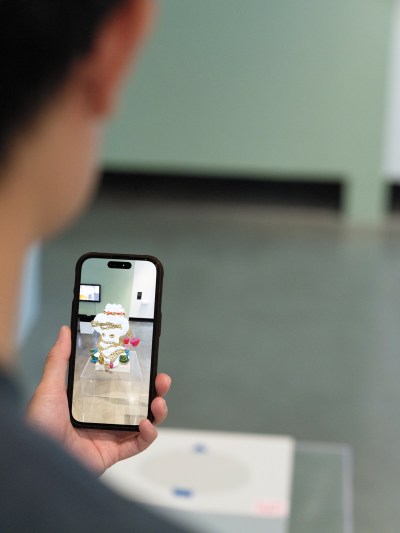Minne Atairu Reimagines Looted Artworks Using AI

Minne Atairu’s Deshrined Ancestors (2024) is a work of augmented reality, an animated 3D rendering of an ivory bust that oscillates between recognizable features and amorphic forms. Is it alien or human? It’s hard to tell. The virtual sculpture appears smooth and rubberlike. Its primary face has cowrie shells for eyes and ram’s-horn handles on each side of its head. The back of the sculpture features a petite totem of two baby doll heads crowned by a strand of red ribbon and adorned with gilded shells. Bulky gold chains wrap around the figure; mini heads in pink, fuchsia, and blue dangle like charms.

Deshrined Ancestors recently featured in the group exhibition “All Watched Over by Machines of Loving Grace” at REDCAT in Los Angeles, an exhibition exploring our evolving relationship with AI. The workis a speculative prototype of a Benin bronze meant to fill the gap left by those works lost and looted. A field recording of ceremonial cries and chants documented in Benin by British anthropologist Northcote W. Thomas between 1909 and 1910 accompanies the online version. Charles Kim’s remix transforms the tribal sounds into a song. In the gallery, there’s an empty podium representing a Benin bronze previously confined by RISD that has since been returned to Nigeria. Atairu troubles the history of stolen Benin bronzes, and echoes calls for repatriation. But rather than simply reiterating critique, she offers a gesture of repair, using AI trained on archives and oral histories, to remedy wounds of colonial violence and erasure.
Born in Benin, Nigeria, Atairu naturally gravitated toward the sacred artifacts that lived there before the 1897 British invasion. Modernism recast ceremonial objects as artworks, and what had belonged to the King of Benin and his people were detained in Western museums for their permanent collections. This stuck with Atairu, who studied art history as an undergraduate at University of Maiduguri, focusing “on various cultural movements in Benin,” pre- and post-colonialization.

The technology part came a little later. The pandemic granted Atairu time to experiment with artmaking in unconventional ways: Given a lack of spatial, financial, and material resources, she began to work with artificial intelligence to develop artworks. Using tools like Midjourney, the artist began generating images of the Yoruba goddess Mami Wata. She works with Blender, converting text into 3D-printed sculptures, as in her 2023 installation at The Shed, To the Hand (2023). Part of “Igùn” (2020–),her series delving into the 17-year interregnum of artistic output under British conquest, To the Hand was also Atairu’s pathway to exploring Benin material culture. After rendering the objects in Blender, she 3D-printed them using PLA filament, a thermoplastic polyester derived from natural sources like cornstarch or sugarcane, then infused with bronze. Surrounding the sculpture were rings of ground terra-cotta representing the walls and deep moats of Benin engineered to protect the kingdom from invaders.
Atairu is well aware of the growing skepticism around AI, especially within communities of color. She noted the racial biases within the system when we spoke. Nevertheless, her practice creates footnotes for creators to address the system’s shortcomings and leaves a trail for future users. She believes in “revealing [issues of racial bias to make] sure that when they are in [our] communities, they don’t traumatize us,” adding that since AI is unlikely to go away, “someone has to do it.”




